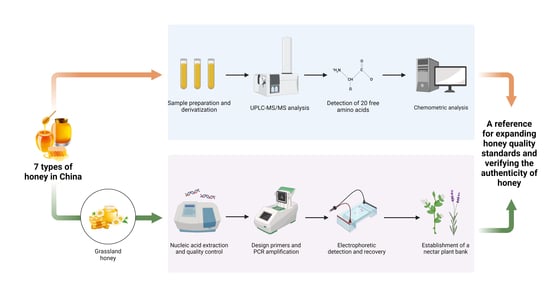Analysis of Free Amino Acid Composition and Honey Plant Species in Seven Honey Species in China
Abstract
1. Introduction
2. Materials and Methods
2.1. Samples
2.2. Chemical Reagents
2.3. Sample Preparation and Derivatization
2.4. UPLC-MS/MS Analysis Conditions
2.5. Nucleic Acid Extraction and Quality Control in Grassland Honey
2.6. Design Primers
2.7. PCR Amplification
2.8. Electrophoretic Detection and Recovery
2.9. Establishment of a Nectar Plant Bank
2.10. Statistical Analyses
3. Results and Discussion
3.1. Method Validation
3.2. Determination of 20 FAAs in Honey
3.3. Chemometric Analysis
4. Conclusions
Author Contributions
Funding
Data Availability Statement
Acknowledgments
Conflicts of Interest
References
- Sah, K.; Chandra, S. Embalming with honey: Quest for an eco-friendly and non-toxic museum. J. Oral Maxillofac. Pathol. 2023, 27, 533–536. [Google Scholar] [PubMed]
- Khan, F.R.; Abadin, Z.U.; Rauf, N. Honey: Nutritional and medicinal value. Int. J. Clin. Pract. 2007, 61, 1705–1707. [Google Scholar] [CrossRef] [PubMed]
- Zheng, X.; Pan, F.; Naumovski, N.; Wei, Y.; Wu, L.; Peng, W.; Wang, K. Precise prediction of metabolites patterns using machine learning approaches in distinguishing honey and sugar diets fed to mice. Food Chem. 2024, 430, 136915. [Google Scholar] [CrossRef] [PubMed]
- Becerril-Sánchez, A.L.; Quintero-Salazar, B.; Dublán-García, O.; Escalona-Buendía, H.B. Phenolic Compounds in Honey and Their Relationship with Antioxidant Activity, Botanical Origin, and Color. Antioxidants 2021, 10, 1700. [Google Scholar] [CrossRef]
- Ranneh, Y.; Akim, A.M.; Hamid, H.A.; Khazaai, H.; Fadel, A.; Zakaria, Z.A.; Albujja, M.; Abu Bakar, M.F. Honey and its nutritional and anti-inflammatory value. BMC Complement. Med. Ther. 2021, 21, 30. [Google Scholar] [CrossRef] [PubMed]
- Ugusman, A.; Shahrin, S.A.S.; Azizan, N.H.; Pillai, S.B.; Krishnan, K.; Salamt, N.; Aminuddin, A.; Hamid, A.A.; Kumar, J.; Mokhtar, M.H. Role of Honey in Obesity Management: A Systematic Review. Front. Nutr. 2022, 9, 924097. [Google Scholar] [CrossRef] [PubMed]
- Waheed, M.; Hussain, M.B.; Javed, A.; Mushtaq, Z.; Hassan, S.; Shariati, M.A.; Khan, M.U.; Majeed, M.; Nigam, M.; Mishra, A.P.; et al. Honey and cancer: A mechanistic review. Clin. Nutr. 2018, 38, 2499–2503. [Google Scholar] [CrossRef] [PubMed]
- Nguyen, H.T.L.; Panyoyai, N.; Kasapis, S.; Pang, E.; Mantri, N. Honey and Its Role in Relieving Multiple Facets of Atherosclerosis. Nutrients 2019, 11, 167. [Google Scholar] [CrossRef] [PubMed]
- Fadzil, M.A.M.; Mustar, S.; Rashed, A.A. The Potential Use of Honey as a Neuroprotective Agent for the Management of Neurodegenerative Diseases. Nutrients 2023, 15, 1558. [Google Scholar] [CrossRef]
- Masad, R.J.; Haneefa, S.M.; Mohamed, Y.A.; Al-Sbiei, A.; Bashir, G.; Fernandez-Cabezudo, M.J.; Al-Ramadi, B.K. The Immunomodulatory Effects of Honey and Associated Flavonoids in Cancer. Nutrients 2021, 13, 1269. [Google Scholar] [CrossRef]
- Dżugan, M.; Tomczyk, M.; Sowa, P.; Grabek-Lejko, D. Antioxidant Activity as Biomarker of Honey Variety. Molecules 2018, 23, 2069. [Google Scholar] [CrossRef] [PubMed]
- Scepankova, H.; Combarros-Fuertes, P.; Fresno, J.M.; Tornadijo, M.E.; Dias, M.S.; Pinto, C.A.; Saraiva, J.A.; Estevinho, L.M. Role of Honey in Advanced Wound Care. Molecules 2021, 26, 4784. [Google Scholar] [CrossRef] [PubMed]
- Schell, K.R.; Fernandes, K.E.; Shanahan, E.; Wilson, I.; Blair, S.E.; Carter, D.A.; Cokcetin, N.N. The Potential of Honey as a Prebiotic Food to Re-engineer the Gut Microbiome Toward a Healthy State. Front. Nutr. 2022, 9, 957932. [Google Scholar] [CrossRef] [PubMed]
- Wang, K.; Wan, Z.; Ou, A.; Liang, X.; Guo, X.; Zhang, Z.; Wu, L.; Xue, X. Monofloral honey from a medical plant, Prunella Vulgaris, protected against dextran sulfate sodium-induced ulcerative colitis via modulating gut microbial populations in rats. Food Funct. 2019, 10, 3828–3838. [Google Scholar] [CrossRef] [PubMed]
- Liu, Y.; Jiang, B.; Wang, K. A review of fermented bee products: Sources, nutritional values, and health benefits. Food Res. Int. 2023, 174, 113506. [Google Scholar] [CrossRef] [PubMed]
- Burlando, B.; Cornara, L. Honey in dermatology and skin care: A review. J. Cosmet. Dermatol. 2013, 12, 306–313. [Google Scholar] [CrossRef] [PubMed]
- Pereira, T.C.; Cruz, A.G.; Guimarães, J.T.; Cravotto, G.; Flores, E.M. Ultrasonication for honey processing and preservation: A brief overview. Food Res. Int. 2023, 174, 113579. [Google Scholar] [CrossRef]
- Hussein, S.Z.; Yusoff, K.M.; Makpol, S.; Mohd Yusof, Y.A. Does gamma irradiation affect physicochemical properties of honey? Clin. Ter. 2014, 165, e125–e133. [Google Scholar]
- Seraglio, S.K.T.; Silva, B.; Bergamo, G.; Brugnerotto, P.; Gonzaga, L.V.; Fett, R.; Costa, A.C.O. An overview of physicochemical characteristics and health-promoting properties of honeydew honey. Food Res. Int. 2019, 119, 44–66. [Google Scholar] [CrossRef]
- Puścion-Jakubik, A.; Borawska, M.H.; Socha, K. Modern Methods for Assessing the Quality of Bee Honey and Botanical Origin Identification. Foods 2020, 9, 1028. [Google Scholar] [CrossRef]
- Kowalski, S.; Kopuncová, M.; Ciesarová, Z.; Kukurová, K. Free amino acids profile of Polish and Slovak honeys based on LC–MS/MS method without the prior derivatisation. J. Food Sci. Technol. 2017, 54, 3716–3723. [Google Scholar] [CrossRef]
- Biluca, F.C.; Bernal, J.; Valverde, S.; Ares, A.M.; Gonzaga, L.V.; Costa, A.C.O.; Fett, R. Determination of Free Amino Acids in Stingless Bee (Meliponinae) Honey. Food Anal. Methods 2019, 12, 902–907. [Google Scholar] [CrossRef]
- Razali, M.T.A.; Zainal, Z.A.; Maulidiani, M.; Shaari, K.; Zamri, Z.; Idrus, M.Z.M.; Khatib, A.; Abas, F.; Ling, Y.S.; Rui, L.L.; et al. Classification of Raw Stingless Bee Honeys by Bee Species Origins Using the NMR- and LC-MS-Based Metabolomics Approach. Molecules 2018, 23, 2160. [Google Scholar] [CrossRef] [PubMed]
- Valverde, S.; Ares, A.M.; Elmore, J.S.; Bernal, J. Recent trends in the analysis of honey constituents. Food Chem. 2022, 387, 132920. [Google Scholar] [CrossRef] [PubMed]
- Łozowicka, B.; Kaczyński, P.; Iwaniuk, P. Analysis of 22 free amino acids in honey from Eastern Europe and Central Asia using LC-MS/MS technique without derivatization step. J. Food Compos. Anal. 2021, 98, 103837. [Google Scholar] [CrossRef]
- Azevedo, M.S.; Seraglio, S.K.T.; Rocha, G.; Balderas, C.B.; Piovezan, M.; Gonzaga, L.V.; Falkenberg, D.D.B.; Fett, R.; de Oliveira, M.A.L.; Costa, A.C.O. Free amino acid determination by GC-MS combined with a chemometric approach for geographical classification of bracatinga honeydew honey (Mimosa scabrella Bentham). Food Control. 2017, 78, 383–392. [Google Scholar] [CrossRef]
- Del Campo, G.; Zuriarrain, J.; Zuriarrain, A.; Berregi, I. Quantitative determination of carboxylic acids, amino acids, carbohydrates, ethanol and hydroxymethylfurfural in honey by 1 H NMR. Food Chem. 2016, 196, 1031–1039. [Google Scholar] [CrossRef] [PubMed]
- Ameri, M.; Daryanavard, S.M. Experimental Design Application for Measuring Histamine in Tuna Fish Samples by Phenyl Isothiocyanate Derivation Method Using Ultra-Performance Liquid Chromatography. J. Chromatogr. Sci. 2023, bmad060. [Google Scholar] [CrossRef]
- Utzeri, V.J.; Ribani, A.; Schiavo, G.; Bertolini, F.; Bovo, S.; Fontanesi, L. Application of next generation semiconductor based sequencing to detect the botanical composition of monofloral, polyfloral and honeydew honey. Food Control. 2018, 86, 342–349. [Google Scholar] [CrossRef]
- Prosser, S.W.; Hebert, P.D. Rapid identification of the botanical and entomological sources of honey using DNA metabarcoding. Food Chem. 2017, 214, 183–191. [Google Scholar] [CrossRef]
- Fröschle, M.; Horn, H.; Spring, O. Characterization of Jatropha curcas honeys originating from the southern highlands of Madagascar. LWT 2018, 93, 525–533. [Google Scholar] [CrossRef]
- Da Silva, P.M.; Gauche, C.; Gonzaga, L.V.; Costa, A.C.O.; Fett, R. Honey: Chemical composition, stability and authenticity. Food Chem. 2016, 196, 309–323. [Google Scholar] [CrossRef]
- Hermosin, I.; Chicón, R.M.; Cabezudo, M.D. Free amino acid composition and botanical origin of honey. Food Chem. 2003, 83, 263–268. [Google Scholar] [CrossRef]
- Sommano, S.R.; Bhat, F.M.; Wongkeaw, M.; Sriwichai, T.; Sunanta, P.; Chuttong, B.; Burgett, M. Amino Acid Profiling and Chemometric Relations of Black Dwarf Honey and Bee Pollen. Front. Nutr. 2020, 7, 558579. [Google Scholar] [CrossRef] [PubMed]
- Bowery, N.G.; Smart, T.G. GABA and glycine as neurotransmitters: A brief history. Br. J. Pharmacol. 2006, 147 (Suppl. S1), S109–S119. [Google Scholar] [CrossRef] [PubMed]
- Castaño, C.; Thomas, A.H.; Lorente, C. Type I Photosensitized Oxidation of Methionine. Photochem. Photobiol. 2020, 97, 91–98. [Google Scholar] [CrossRef] [PubMed]
- Martínez, Y.; Li, X.; Liu, G.; Bin, P.; Yan, W.; Más, D.; Valdivié, M.; Hu, C.-A.A.; Ren, W.; Yin, Y. The role of methionine on metabolism, oxidative stress, and diseases. Amino Acids 2017, 49, 2091–2098. [Google Scholar] [CrossRef] [PubMed]
- Sun, Z.; Zhao, L.; Cheng, N.; Xue, X.; Wu, L.; Zheng, J.; Cao, W. Identification of botanical origin of Chinese unifloral honeys by free amino acid profiles and chemometric methods. J. Pharm. Anal. 2017, 7, 317–323. [Google Scholar] [CrossRef]
- Pereira, V.; Pontes, M.; Câmara, J.; Marques, J. Simultaneous analysis of free amino acids and biogenic amines in honey and wine samples using in loop orthophthalaldeyde derivatization procedure. J. Chromatogr. A 2008, 1189, 435–443. [Google Scholar] [CrossRef]
- Iglesias, M.T.; de Lorenzo, C.; Polo, M.D.C.; Martín-Álvarez, P.J.; Pueyo, E. Usefulness of amino acid composition to discriminate between honeydew and floral honeys. Application to honeys from a small geographic area. J. Agric. Food Chem. 2003, 52, 84–89. [Google Scholar] [CrossRef]
- Kečkeš, J.; Trifković, J.; Andrić, F.; Jovetić, M.; Tešić, Z.; Milojković-Opsenica, D. Amino acids profile of Serbian unifloral honeys. J. Sci. Food Agric. 2013, 93, 3368–3376. [Google Scholar] [CrossRef] [PubMed]
- Kelly, M.T.; Blaise, A.; Larroque, M. Rapid automated high performance liquid chromatography method for simultaneous determination of amino acids and biogenic amines in wine, fruit and honey. J. Chromatogr. A 2010, 1217, 7385–7392. [Google Scholar] [CrossRef] [PubMed]
- Karabagias, I.K.; Vlasiou, M.; Kontakos, S.; Drouza, C.; Kontominas, M.G.; Keramidas, A.D. Geographical discrimination of pine and fir honeys using multivariate analyses of major and minor honey components identified by 1H NMR and HPLC along with physicochemical data. Eur. Food Res. Technol. 2018, 244, 1249–1259. [Google Scholar] [CrossRef]
- Kuś, P.M. Honey as Source of Nitrogen Compounds: Aromatic Amino Acids, Free Nucleosides and Their Derivatives. Molecules 2020, 25, 847. [Google Scholar] [CrossRef] [PubMed]
- Boffo, E.F.; Tavares, L.A.; Tobias, A.C.; Ferreira, M.M.; Ferreira, A.G. Identification of components of Brazilian honey by 1H NMR and classification of its botanical origin by chemometric methods. LWT 2012, 49, 55–63. [Google Scholar] [CrossRef]
- Mann, G.; Mora, S.; Madu, G.; Adegoke, O.A.J. Branched-chain Amino Acids: Catabolism in Skeletal Muscle and Implications for Muscle and Whole-body Metabolism. Front. Physiol. 2021, 12, 702826. [Google Scholar] [CrossRef]
- Fouré, A.; Bendahan, D. Is Branched-Chain Amino Acids Supplementation an Efficient Nutritional Strategy to Alleviate Skeletal Muscle Damage? A Systematic Review. Nutrients 2017, 9, 1047. [Google Scholar] [CrossRef] [PubMed]
- Takeshita, Y.; Takamura, T.; Kita, Y.; Ando, H.; Ueda, T.; Kato, K.; Misu, H.; Sunagozaka, H.; Sakai, Y.; Yamashita, T.; et al. Beneficial effect of branched-chain amino acid supplementation on glycemic control in chronic hepatitis C patients with insulin resistance: Implications for type 2 diabetes. Metabolism 2012, 61, 1388–1394. [Google Scholar] [CrossRef]
- Janiszewska, K.; Aniołowska, M.; Nowakowski, P. Free Amino Acids Content of Honeys from Poland. Pol. J. Food Nutr. Sci. 2012, 62, 85–89. [Google Scholar] [CrossRef]
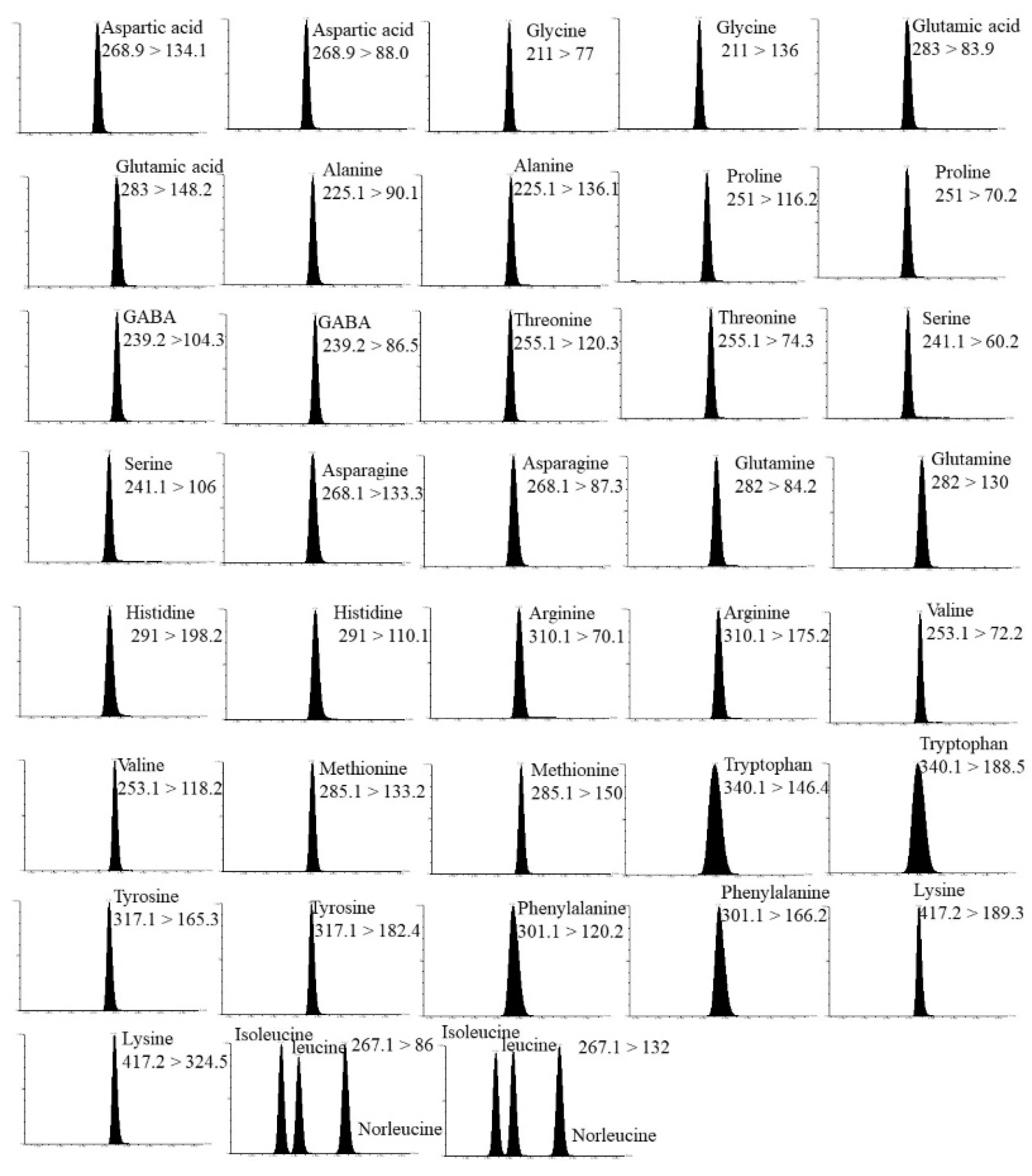
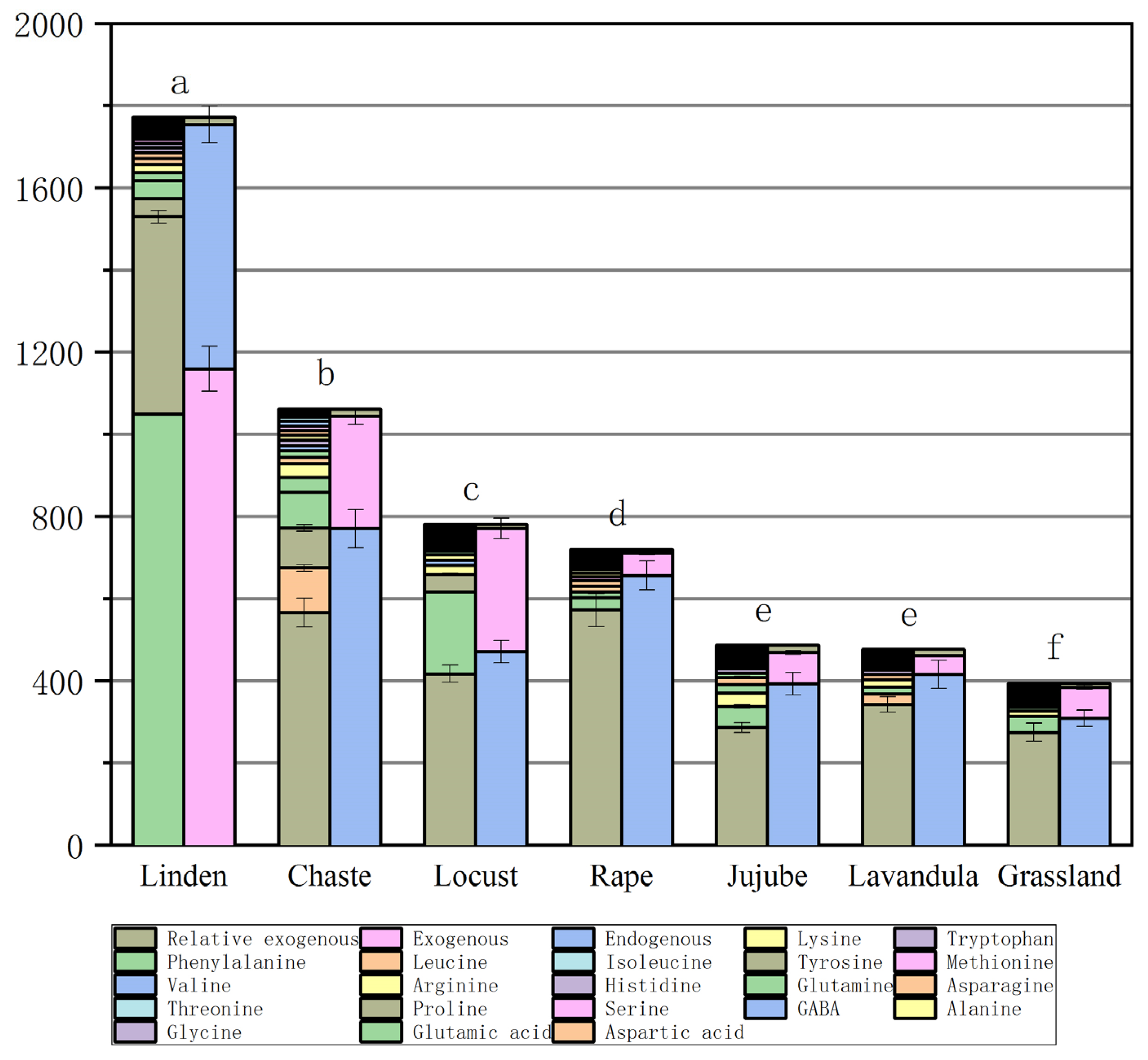
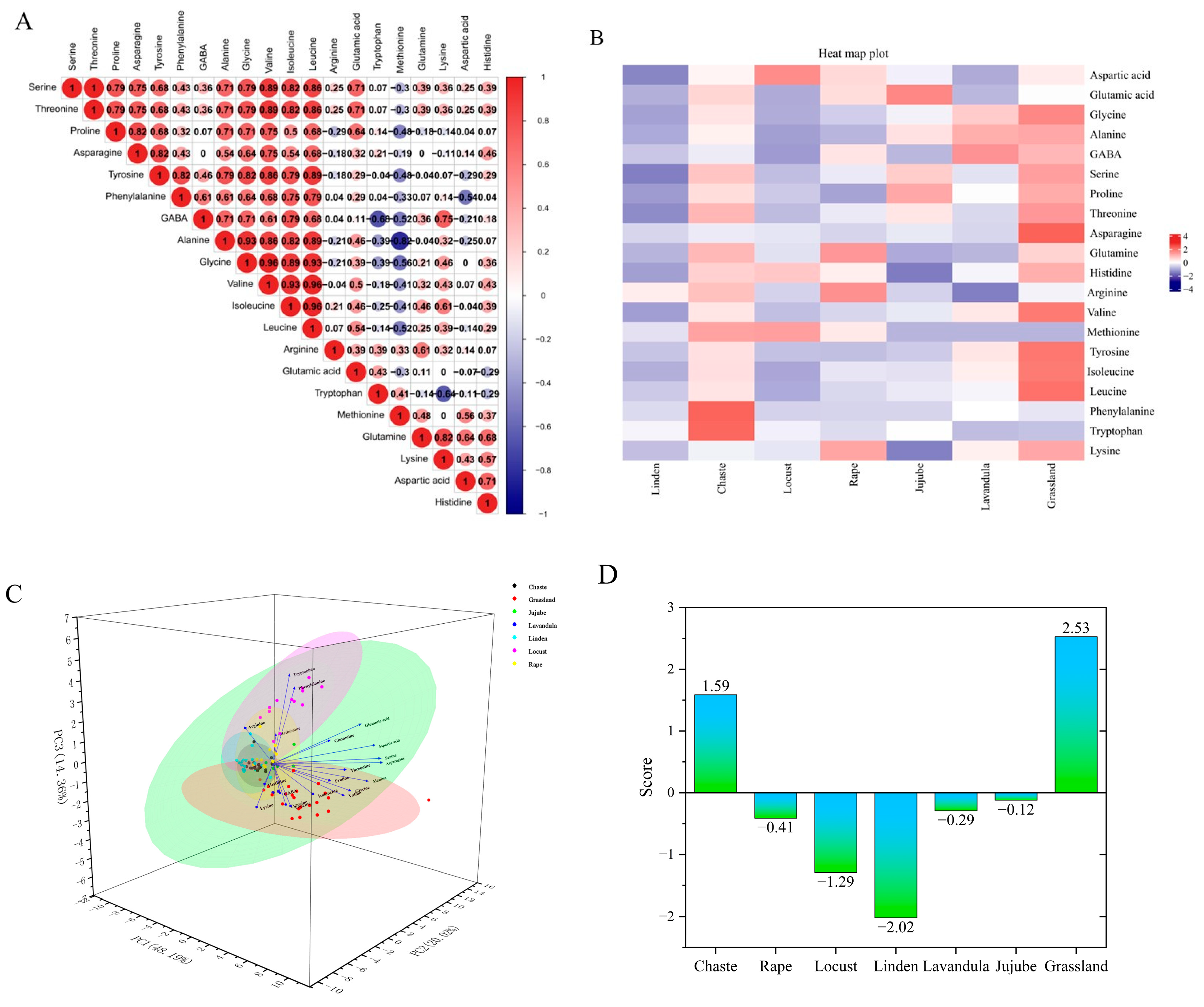
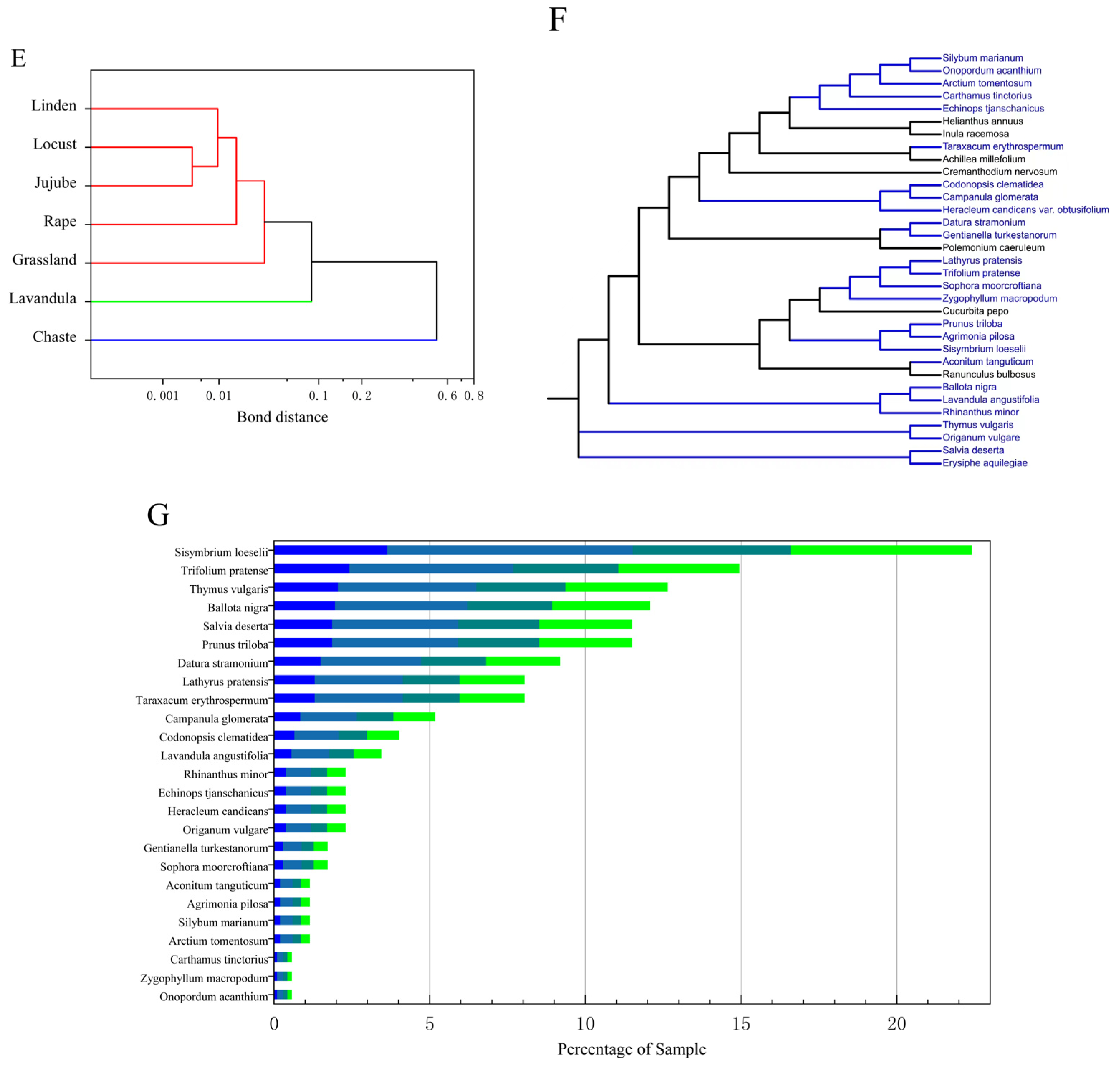
| Type of Honey | Number of Samples | Area of Collection | Date of Collection | Number of Acquisitions | Beehive Location |
|---|---|---|---|---|---|
| Linden honey | L1-L14 | Jilin | July 2021 | 20 | Yanbian Prefecture, Jilin Province, China, mountainous area, 128°54′ N, 43°7′ E |
| L15-L16 | Jilin | July 2022 | |||
| L17 | Heilongjiang | July 2023 | China, mountainous area of Raohe County, Heilongjiang, 134°01′ N, 46°48′ E | ||
| L18 | Heilongjiang | July 2021 | |||
| L19-L20 | Heilongjiang | July 2022 | |||
| Chaste honey | T21 | Shanxi | June 2022 | 13 | China, Shanxi Lingshi County area, 111°47′ N, 36°51′ E |
| T22, T23 | Shanxi | June 2021 | |||
| T24-T25 | Liaoning | June 2023 | China, Liaoning Chaoyang County area, 120°23′ N, 41°29′ E | ||
| T26-T28 | Hebei | June 2023 | China, Hebei Qianxi County area, 118°19′ N, 40°8′ E | ||
| T29 | Hebei | June 2022 | |||
| T30 | Hebei | June 2023 | |||
| T31 | Hebei | June 2022 | |||
| T32 | Henan | June 2022 | China, Yichuan County area, Henan, 112°25′ N, 34°25′ E | ||
| T33 | Henan | June 2021 | |||
| Locust honey | LO34 | Gansu | June 2023 | 19 | China, Tianshui County area, Gansu, 105°53′ N, 34°34′ E |
| LO35-LO36 | Gansu | May 2022 | |||
| LO37-LO39 | Hebei | May 2023 | China, Hebei Qianxi County area, 118°19′ N, 40°8′ E | ||
| LO40-LO41 | Shanxi | May 2023 | China, Shanxi Lingshi County area, 111°47′ N, 36°51′ E | ||
| LO42 | Shanxi | June 2021 | |||
| LO43-LO48 | Shaanxi | June 2023 | China, Yichuan County area, Yan’an City, Shaanxi Province, 110°8′ N, 36°17′ E | ||
| LO49-LO52 | Shaanxi | June 2022 | |||
| Rape honey | RA53-RA55 | Anhui | March 2022 | 11 | China, Anhui Susong County area, 116°56′ N, 30°9′ E, Agricultural land |
| RA56-RA57 | Sichuan | March 2022 | China, Cangxi County Area, Guangyuan City, Sichuan, 105°56′ N, 31°44′ E, Agricultural Land | ||
| RA58-RA60 | Sichuan | March 2023 | |||
| RA61-RA63 | Qinghai | July 2023 | China, Qinghai Menyuan County Area, 101°37′ N, 37°22′ E, Agricultural Land | ||
| Jujube honey | JU64 | Shanxi | June 2021 | 5 | China, Shanxi Region, Mountainous Area, 110°59′ N, 37°57′ E, Agricultural Land |
| JU65 | Shanxi | June 2021 | |||
| JU66 | Shanxi | May 2022 | |||
| JU67 | Shanxi | May 2023 | |||
| JU68 | Shanxi | June 2022 | |||
| Lavandula honey | LA69-LA70 | Xinjiang | July 2023 | 2 | China, Yili Prefecture, Huocheng County Area, 83°25′ N, 43°44′ E, Wild Natural Grassland |
| Grassland honey | GR71-GR93 | Xinjiang | July 2023 | 23 | China, Nilek County District, Yili Prefecture, Mountainous Area, 80°54′ N, 44°17′ E, Agricultural Land |
| Primer Name | Sequences |
|---|---|
| ITS1-F | 5′-TCCGTAGGTGAACCTGCGG-3′ |
| ITS1-R | 5′-TCCTCCGCTTATTGATATGC-3′ |
| ITS2-F | 5′-ATGCGATACTTGGTGTGAAT-3′ |
| ITS2-R | 5′-GACGCTTCTCCAGACTACAAT-3′ |
| ITS3-F | 5′-GGAAGTAAAAGTCGTAACAAGG-3′ |
| ITS3-R | 5′-TCCTCCGCTTATTGATATGC-3′ |
| Amino Acid Types | Quantitative Ion Pair/(m/z) | Qualitative Ion Pairs/(m/z) | Monitoring Time/(s) | Foraminal Voltage/(V) | Crash Voltage/(V) |
|---|---|---|---|---|---|
| Aspartic acid | 268.9/134.1 | 268.9/88 | 0.1, 0.1 | 40, 40 | 10, 20 |
| Glutamic acid | 283/148.2 | 283/83.9 | 0.1, 0.1 | 40, 40 | 10, 30 |
| Glycine | 211/136 | 211/77 | 0.02, 0.02 | 30, 30 | 15, 30 |
| Alanine | 225.1/90.1 | 225.1/136.1 | 0.02, 0.02 | 35, 35 | 10, 20 |
| GABA | 239.5/86.5 | 239.5/104.3 | 0.02, 0.02 | 35, 35 | 15, 10 |
| Serine | 241.1/106 | 241.1/60.2 | 0.02, 0.02 | 35, 35 | 10, 20 |
| Proline | 251/116.2 | 251/70.2 | 0.02, 0.02 | 40, 40 | 15, 25 |
| Threonine | 255.1/120.3 | 255.1/74.3 | 0.02, 0.02 | 35, 35 | 10, 20 |
| Asparagine | 268.1/133.1 | 268.1/87.3 | 0.02, 0.02 | 35, 35 | 10, 20 |
| Glutamine | 282/84.2 | 282/130 | 0.02, 0.02 | 40, 40 | 25, 20 |
| Histidine | 291/198.2 | 291/110.1 | 0.02, 0.02 | 35, 35 | 10, 25 |
| Arginine | 310.1/175.2 | 310.1/70.1 | 0.02, 0.02 | 40, 40 | 35, 15 |
| Valine | 253.1/72.2 | 253.1/118.2 | 0.05, 0.05 | 35, 35 | 15, 10 |
| Methionine | 285.1/150 | 285.1/133.2 | 0.05, 0.05 | 30, 30 | 10, 20 |
| Tyrosine | 317.1/165.3 | 317.1/182.4 | 0.05, 0.05 | 35, 35 | 15, 10 |
| Phenylalanine | 301.1/166.2 | 301.1/120.2 | 0.05, 0.05 | 40, 40 | 10, 20 |
| Tryptophan | 340.1/188.5 | 340.1/146.4 | 0.05, 0.05 | 40, 40 | 15, 30 |
| Lysine | 417.2/189.3 | 417.2/324.5 | 0.05, 0.05 | 35, 35 | 20, 15 |
| Leucine | 267.1/86 | 267.1/132 | 0.1, 0.1 | 40, 40 | 20, 10 |
| Isoleucine | 267.1/86 | 267.1/132 | 0.1, 0.1 | 40, 40 | 20, 10 |
| Norleucine(IS) | 267.1/86 | 267.1/132 | 0.1, 0.1 | 40, 40 | 20, 10 |
| Sum of Endogenous FAAs (mg/kg) | Sum of Exogenous FAAs (mg/kg) | Sum of FAAs (mg/kg) | SD | Ratio of Exogenous/Endogenous FAAS | Sum of Hydrophobic Pyruvate Derivates (mg/kg) Val + Ile + Leu | Max Concentrations of FAAs (mg/kg) | Min Concentrations of FAAs (mg/kg) | Median Concentrations of FAAs (mg/kg) | |
|---|---|---|---|---|---|---|---|---|---|
| Linden | 308.81 | 75.38 | 394.4 | 98.35 | 0.24 | 8.10 | 670.370 | 244.800 | 354.136 |
| Chaste | 594.57 | 1159.18 | 1771.7 | 116.02 | 1.95 | 20.58 | 2282.900 | 1295.270 | 1784.832 |
| Locust | 415.34 | 44.95 | 476.1 | 39.92 | 0.11 | 7.85 | 652.500 | 328.190 | 476.570 |
| Rape | 393.03 | 75.68 | 486.4 | 54.14 | 0.19 | 12.68 | 617.800 | 350.540 | 461.840 |
| Jujube | 656.53 | 55.49 | 719.3 | 119.90 | 0.08 | 13.94 | 847.160 | 599.052 | 680.223 |
| Lavandula | 470.89 | 299.40 | 780.9 | 340.93 | 0.64 | 18.05 | 933.308 | 628.580 | 780.944 |
| Grassland | 770.31 | 273.75 | 1061.9 | 69.14 | 0.36 | 35.66 | 670.370 | 244.800 | 354.136 |
Disclaimer/Publisher’s Note: The statements, opinions and data contained in all publications are solely those of the individual author(s) and contributor(s) and not of MDPI and/or the editor(s). MDPI and/or the editor(s) disclaim responsibility for any injury to people or property resulting from any ideas, methods, instructions or products referred to in the content. |
© 2024 by the authors. Licensee MDPI, Basel, Switzerland. This article is an open access article distributed under the terms and conditions of the Creative Commons Attribution (CC BY) license (https://creativecommons.org/licenses/by/4.0/).
Share and Cite
Yang, J.; Liu, Y.; Cui, Z.; Wang, T.; Liu, T.; Liu, G. Analysis of Free Amino Acid Composition and Honey Plant Species in Seven Honey Species in China. Foods 2024, 13, 1065. https://doi.org/10.3390/foods13071065
Yang J, Liu Y, Cui Z, Wang T, Liu T, Liu G. Analysis of Free Amino Acid Composition and Honey Plant Species in Seven Honey Species in China. Foods. 2024; 13(7):1065. https://doi.org/10.3390/foods13071065
Chicago/Turabian StyleYang, Jialin, Yihui Liu, Zongyan Cui, Taohong Wang, Tong Liu, and Gang Liu. 2024. "Analysis of Free Amino Acid Composition and Honey Plant Species in Seven Honey Species in China" Foods 13, no. 7: 1065. https://doi.org/10.3390/foods13071065
APA StyleYang, J., Liu, Y., Cui, Z., Wang, T., Liu, T., & Liu, G. (2024). Analysis of Free Amino Acid Composition and Honey Plant Species in Seven Honey Species in China. Foods, 13(7), 1065. https://doi.org/10.3390/foods13071065




